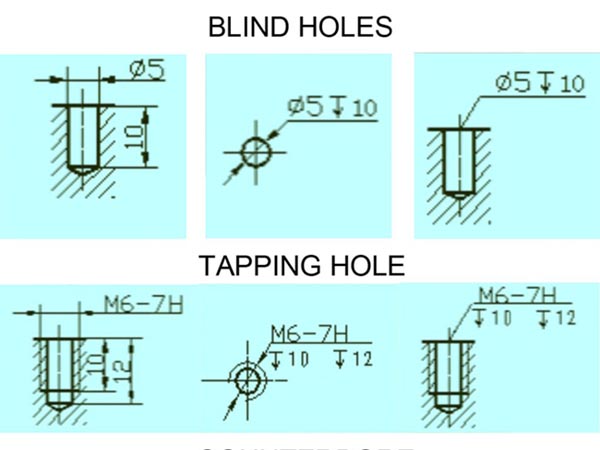
Tapping Strategies for Blind, Counterbored, and Through Holes: Practical Techniques and Tool Optimization
In metal cutting operations, tapping for blind holes, counterbores, and through holes may appear routine, but each involves complex technical logic. Blind holes pose a risk of tool breakage due to chip accumulation at the closed bottom. Counterbores demand precise coaxiality between the thread axis and stepped surface. Through holes often produce burrs at the exit, affecting assembly accuracy. The fundamental structural differences among these hole types dictate unique patterns in load distribution, chip evacuation, and thermal deformation during tapping.
This article compares real-world machining data to analyze suitable tap types and optimal usage methods for each hole type, helping standard tools achieve professional-grade threading results.



| Metric | Cutting Tap | Forming Tap |
|---|---|---|
| Burr Height | 0.1 mm | ≤0.02 mm |
| Thread Strength | 100% | 120% |
| Tool Cost | 1× | 1.8× |
| Tap Type | Applicable Hole Type | Key Features | Suitable Materials |
|---|---|---|---|
| Spiral Flute Tap | Deep Blind Hole (>2D) | Spiral chip evacuation, anti-jamming | Stainless steel, aluminum alloys |
| Straight Flute Tap | Through/Shallow Blind (≤1.5D) | Simple and cost-effective | Cast iron, hard materials |
| Gun Nose Tap | Through Hole/Thin Plate | Spiral tip reduces burrs | Carbon steel, thin sheet (<3mm) |
| Bottom Forming Tap | Precision Blind/Thin-Wall | Chipless, strong threads | Low carbon steel, aluminum (>8% EL) |
| Roll Form Tap | Deep Blind/Micro Holes (<M3) | No chips, long tool life | Stainless/alloy steels |
| Bottom Cutting Tap | Stepped Holes/Hard Substrates | Accurate minor diameter control | Pre-hardened steel (HRC35–40) |
| Nut Tap | Pass-Through Nuts/Stepped | Long guide, dual taper design | Medium carbon/alloy steels |
| Pipe Thread Tap | NPT/G Threads | Tapered for sealing | Carbon steel, copper alloys |

| Hole Type | First Choice Tap | Backup Option | Avoid Using |
|---|---|---|---|
| Deep Blind | Spiral Flute / Roll Form | Bottom Forming | Straight Flute |
| Through | Gun Nose / Forming Tap | Regenerated Worn Taps | Nut Tap |
| Counterbore | Extended Bottom Cutting | Modular Combo Tap | Standard Spiral Flute |
| Pipe Thread | Tapered Pipe Thread Tap | Custom Non-Standard Tap | Standard Straight Flute Tap |
| Hole Type | Material | Tap Type | Spindle Speed (rpm) | Feed Rate (mm/min) | Coolant Method |
|---|---|---|---|---|---|
| Blind | Stainless Steel | Spiral Flute HSS-E | 80–100 | 95 | High-pressure tapping oil |
| Counterbore | Aluminum | Extended Guide Tap | 350–400 | 420 | Alcohol mist spray |
| Through | Carbon Steel | Gun Nose Tap | 120–150 | 180 | Emulsion (8%) |
| Blind | Cast Iron | Modified Tooth Tap | 60–80 | 75 | Graphite + Oil |
| Through | Brass | Forming Tap | 250–300 | 200 | Dry cutting |
Tapping is fundamentally about precision control over material removal and thread forming. The structural characteristics of blind, counterbored, and through holes define distinct technical challenges. Blind hole tapping emphasizes chip control via increased spiral angles (40°–45°) and intermittent withdrawal. Counterbore tapping depends on extended guides (+2–3mm) and reduced speeds (15%–20%) to maintain coaxiality. Through hole operations require optimized breakthrough angles (8°–12°) and feed compensation (20% deceleration at the exit) to minimize burrs.
These solutions are grounded in the interplay of cutting forces, heat transfer, and material deformation. Standard taps can achieve over 95% thread qualification rates when enhanced with geometric modifications and procedural adjustments. When pre-tap hole depth follows the “Effective Thread + 1.5P” rule, counterbore flatness stays within 0.05mm, and through holes are pre-chamfered, even basic tooling can deliver exceptional performance.
Ultimately, tapping quality hinges on deep understanding and precise control over the coupling relationship between hole type, tooling, and cutting parameters.

 We like to do design according to all the customers' requirements, or offer them our new designs. With strong OEM/ODM capabilities, we can fill your sourcing demands.
We like to do design according to all the customers' requirements, or offer them our new designs. With strong OEM/ODM capabilities, we can fill your sourcing demands.